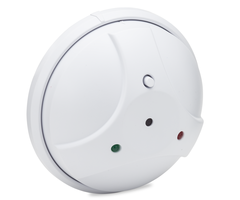How Do You Add a 2GIG GB1 to the 2GIG GC3?
You can add a 2GIG GB1 to the 2GIG GC3 through the zone programming menu of the panel. This is also where you can change any settings for the glass break. You will need the installer code for the GC3 to access this menu. Make sure to test the glass break after it has been programmed.

Complete the following steps to add the GB1 to the GC3:
- Access system programming. From the home screen of the panel, go to System Settings > enter the installer code (the default code is 1561) > Installer Toolbox > System Configuration > Wireless Zones. You will now be at the system programming menu.
- Program the GB1. Select an available zone, and press the "Edit" button to make changes to its configuration. This will allow you to program the GB1. The table below shows all of the programming fields that can be found on this screen and the corresponding selections that should be made. After each setting has been adjusted, press the down arrow to move to the next prompt:
- Return to the home screen. After programming the last entry for the zone, you can either move on to the next zone, or you can press Back to Zones > Return to System Configuration > Left Arrow Button > Save. This will save the programming and return the system to the home screen.
- Test the sensor. Make sure that your central station has the system on test and will not dispatch on alarms before testing the glass break. The FG-701 glass break simulator is compatible with the 2GIG GB1. There are no instructions specific to testing the GB1, so follow the instructions for the FG-701.
|
Programming Fields |
Field Selections |
|
Sensor Type |
“03 - Perimeter” Glass break sensors are typically programmed with the Perimeter zone type. With this setting, the device will be active in any armed state, with no entry or exit delay. |
|
Equipment Code |
Select “0864 - 2GIG Glass Break Detector”. You can press the button with three horizontal bars in the upper-right portion of the screen to view and select from a list of equipment codes, or you can simply enter in 0864. |
|
Serial Number |
The recommended method for adding the serial number is to learn it into the system. Click the "Learn" button on the GC3, and then remove the glass break sensor from its mounting base and re-attach it. The GC3 will show "Sensor Received" with the serial number displayed. Press "Accept". |
|
Equipment Age |
This won’t change how the system operates. Select "New" or "Existing". |
|
Sensor Loop |
The GB1 uses Loop 1. |
|
Transmission Delay |
Unless specifically required, leave this disabled. Enabling this entry adds a 15, 30 or 45 second delay between the time the zone shows an alarm and the time that it reports the alarm to the monitoring station. This is a false alarm prevention feature that is only required in certain areas. |
|
Voice Descriptor |
Give the device a voice descriptor. This will will help you differentiate the glass break sensor from other devices. Press "Edit Voice Descriptor", and then begin typing the first word of the descriptor. Words matching the characters you type will pop up. Once the word you want is displayed, press it. Keep doing so until the voice descriptor is complete. Then press the "Done" button in the lower-right corner.. |
|
Sensor Reports |
Enabling this field causes an alarm on the glass break detector to be reported to the monitoring station. |
|
Sensor Supervised |
Unless specifically required for an installation application, this field should always be enabled. When enabled, the panel listens for periodic check-in signals from the device. If the panel doesn't hear from the device after a certain period of time, the system will display a trouble condition for that zone. |
|
Sensor Chime |
Chime is used for doors and windows to alert the user when a device has been opened while the system is in a disarmed state. This is usually not enabled for glass break detectors. |
Did you find this answer useful?
We offer alarm monitoring as low as $10 / month
Click Here to Learn MoreRelated Products
Related Videos
Related Categories
- Wireless Alarm Control Panels
- DIY Wireless Security Systems
- Transmitters
- Wireless Peripheral Sensors
- Wireless Glass Break Detectors
- Glass Break Detectors
- Answered
- Answered By
- Joe Gonnella



